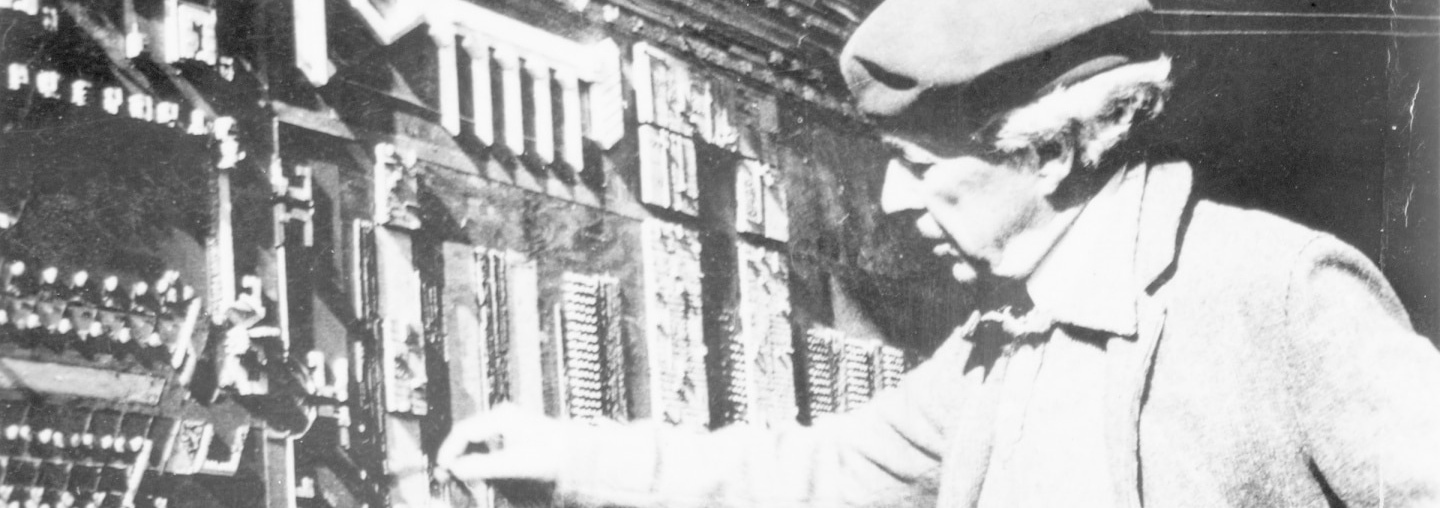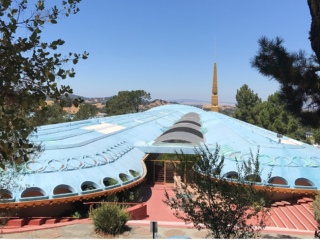
The Form and Function of Science Fiction
Fred Scharmen | Nov 15, 2019
Science fiction and architecture are both practices that imagine—and critique—new worlds. Frank Lloyd Wright’s work was both a critique of the way we build and a projection about how our built world could change. Wright wasn’t just designing a new built environment, his work was always also addressing the political and economic architecture of future societies. Some particular examples of the way in which his projects have been used in science fiction show the complicated relationship between his social and spatial imaginations.
Header image: Frank Lloyd Wright completes a final inspection of his Broadacre City model in 1935.
Manfredo Tafuri argued that building and designing was always about Utopia. New, modern architecture, he says in his book Architecture and Utopia, offers new futures and ways of life, but with a caveat. Tafuri points out that the radical Utopian novelty of modern architecture has a social function: the seeming ruptures with the past, and the new aesthetic modes, are actually acting to assimilate technological and social change without allowing society to break down.1 This is the same function that Le Corbusier references when he says, in Towards a New Architecture, that “it is a question of building which is at the root of all social unrest today; architecture or revolution.”2 Following on from Tafuri, critic Fredric Jameson, in his 2005 book Archaeologies of the Future: the Desire Called Utopia and Other Science Fictions, defines the function of Utopianism as the mediation of “identity and difference.” He further stipulates that all Utopian thinking is ultimately a “socio-economic subgenre”3 of science fiction.
If architecture is always Utopian, and Utopianism is always science fictional, then architecture is science fiction. The key aspiration that links these three modes together—for better or worse—is something Tafuri identifies, again with a caveat. Architecture, Utopianism, and science fiction all seek to describe, “a ‘total’ resolution of the technological universe.”4
That word “resolution” could apply equally well to a design intervention, or to the conclusion of a narrative. If worlds are disrupted by technology or social change, architecture, and science fiction both try to make sense of that disruption and mediate its impact by getting out ahead of it, anticipating and telling stories about how life might, at best, benefit from change, or, at worst, go on in spite of it. The aspiration toward totality applies equally to both design and worldbuilding, two impulses that converge in the work of Frank Lloyd Wright.

Perspective rendering of Frank Lloyd Wright’s Living City (Broadacre City)
Wright’s organic architecture was a method of integrating and coordinating design ideas across multiple scales and regimes. His Broadacre City project of 1932–1959 is perhaps the most often cited example of Wright’s ambitions to totalistic worldbuilding. In Broadacre, the new interventions that are threatening to tear apart the American landscape are tamed, and everything that might be affected by new materials or technology is assimilated and mediated through design:
… giant roads, themselves great architecture, pass public service stations, no longer eyesores, expanded to include all kinds of service and comfort. They unite and separate—separate and unite the series of diversified units, the farm units, the factory units, the roadside markets, the garden schools, the dwelling places (each on its acre of individually adorned and cultivated ground), the places for pleasure and leisure … This integral whole composes the great city that I see embracing all of this country—the Broadacre City of tomorrow.5
Wright’s operations to “unite and separate—separate and unite” diversity are a way of dealing with the identity and difference that Jameson writes about. This is Utopian design thinking, with his “aerator” helicopter cars, and—in some versions of Broadacre—his Mile High “Illinois” tower on the horizon, the integration of Utopia, architecture, and science fiction modes is fully realized. In Wright’s idea to provide an acre of ground to each citizen, his Utopian impulses combine economics with regional planning. Elsewhere, the scale and scope of Wright’s organic design intentions included zooming in to furniture, fixtures, and even flatware. But here he is going for the widest possible angle, and what science fiction world would be complete without flying cars and mile-high skyscrapers?
Wright used this project for—among other things—maintaining a catalogue of unbuilt work, like the “Illinois.” But his built work has had other lives within other science fiction worlds, none of them as totalistically integrated as Broadacre. In the three most popular films that use Wright’s buildings for sets: The Ennis House (1924) in Blade Runner (1982), the Marin County Civic Center (1957) in Gattaca (1997), and the Robie House (1909) in Cowboy Bebop (2001), the worlds are not coming together, but falling apart. In these films, Wright’s architecture—especially his interiors—creates particular kinds of spaces. These are oases of calm order and privilege within worlds that are otherwise chaotic, broken, and uneven.

Ennis House textile blocks
In Blade Runner, the Ennis House’s repetitive concrete textile blocks create a self-referential set of interior spaces on the 97th floor of an apartment tower, above a dark and rainy street level. This is a refuge for Deckard, the main character, where he grapples with his own questions about the identity of himself and others, and struggles to enforce his society’s laws against those who have been artificially designed and produced as subhuman. As Deckard’s boss says, when he tries to avoid the job entirely, “Stop right where you are! You know the score pal. If you’re not cop, you’re little people.”6
The world of Gattaca is similarly stratified: spatially, socially, and biologically. Here, there are hard divisions between those who are valid, that is, genetically screened and engineered for certain intellectual and athletic talents, and those who are in-valid, conceived with traditionally random genetic combinations, and left to perform menial and unskilled labor. The Marin County Civic Center becomes a training facility for space pilots, in which an in-valid passes as a valid. He overcomes the limits that his world has placed on him, and, with help, earns the right to leave it.7

Marin County Civic Center, Photo by Andrew Pielage
In Cowboy Bebop, the movie based on the popular anime series of the same name, the principal interior space from the Robie House has been recast as the inner sanctum of Cherious Medical, a shadowy military bioweapon company. The action of the film takes place inside a domed city on Mars. The protagonists work to stop a terrorist who has stolen an infectious nanotechnological weapon from Cherious, intending to use it to deal with his own past trauma by wiping out all human life in the Martian settlement.8
In contrast to the way that Wright uses his own individual works to compose a coherent whole world in Broadacre, these films place Wright’s pieces as fragments beside still other fragments. These are worlds that lack the totalizing integrated singular design ambitions that define Wright’s Utopia.
Or if those ambitions exist, they are projected from within Wright’s spaces, and that projection of authority over society and biology that organic architecture implies is a source of conflict within these films’ worlds.
Tafuri makes no distinction between Utopia and Dystopia, except to note the existence of the “negative Utopia” in worlds depicted by designers like Piranesi, himself the illustrator of fragmented worlds. For Tafuri, all Utopias are inherently critical of society, as they mediate between identity and difference. Wright’s organic architecture, in Broadacre City, was meant to be the outward and visible mediator for a set of invisible social, economic, and political systems that he also designed. But, like his mile-high skyscraper, these other structures also remained unbuilt. Effective architecture acts in at least two registers: spatially and culturally. Attending to the way in which cultural regimes like science fiction repurpose architecture shows us that if architectural Utopianism is a kind of social critique, then there is still the possibility for further criticism of the way in which that critique proceeds. The aesthetic modes of Wright’s organic architecture were always meant to apply to social, political—even biological—life, and science fiction shows us what happens when that application is spread unevenly.
1. Manfredo Tafuri, Architecture and Utopia: Design and Capitalist Development, trans. Barbara Luigia La Penta (Cambridge, MA: MIT Press, 1976), 100. 2. Le Corbusier, Towards a New Architecture, trans. Frederick Etchells (1931; reprint, New York: Dover, 1986), 269. 3. Fredric Jameson, Archaeologies of the Future: The Desire Called Utopia and Other Science Fictions (New York: Verso, 2005), xiv. 4.Tafuri, Architecture and Utopia, 160.5.Frank Lloyd Wright, The Disappearing City (New York: William Farquar Payson, 1932), 44. 6. Blade Runner, directed by Ridley Scott (Burbank: Warner Brothers, 1982) 7.Gattaca, directed by Andrew Niccol (Los Angeles: Columbia Pictures, 1997) 8. Cowboy Bebop: The Movie, directed by Shinichirō Watanabe (Tokyo: Sony Pictures Entertainment Japan, 2001)
Fred Scharmen teaches architecture and urban design at Morgan State University’s School of Architecture and Planning. He is currently finishing his first book, Space Settlements—on NASA’s 1970s proposal to construct large cities in space for millions of people—out in July 2019 from Columbia Books on Architecture and the City. He received his master’s degree in architecture from Yale University. His writing has been published in the Journal of Architectural Education, Log, CLOG, Volume, and Domus. His architectural criticism has appeared in the Architects Newspaper, and in the local alt-weekly Baltimore City Paper.
This article originally appeared in the spring 2019 issue of the Frank Lloyd Wright Quarterly magazine, “Timeless: Frank Lloyd Wright + Contemporary Pop Culture.”


